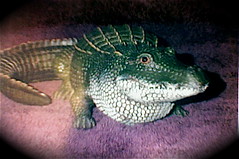
During the same weeks that have borne witness to chaos in Cairo--with the shocking and convulsive events in Tahrir Square aimed at ending the 30-year regime of Hosni Mubarak--in New York, the fashion industry was on a roll. I should immediately point out that not all revolutions are political--and having been turned on recently to the current revolution in fashion by a new young friend, Alex Harrington, I happened to notice in, of all places, the Wall Street Journal, a front-page review on the industry's latest extravaganza: clothes made entirely of FOOD. Unhinging events might be happening in the Middle East that are draining stability right off the planet, but I am going to shock myself and everyone else by writing instead about waffle pants, octopus ski hats, and cabbage dresses.
The fact that we now live in a marketing wonderland of totally surreal objects called "clothes," is for me just another parable for life in "end times." That said, however, the kale collars and cherry necklaces featured in Barney's holiday catalogue are undoubtedly more fun to ponder than what is happening in the Middle East. Maybe it all started when MTV gave its Video Music Award to Lady Gaga, who shocked everyone by wearing a dress and shoes made from strips of flank steak. But if you want to check out this latest fashion phenomenon further, Google "Hunger Pains" on the Internet. It's the title of a photo shoot by Ted Sabarese, documenting the young avant-garde designers who make dresses from chocolate or fresh croissants, create astounding shoulder pads with loaves of challah--or, as in the photo here, invent an evening gown fabricated entirely of artichoke leaves (by Wesley Nault).
As for my new friend Alex, he is a young fashionista living in Brooklyn and working as a stylist. I met him recently at the home of his parents in Roanoke, when he was visiting them over the holidays. We bonded over the fact that I took serious note of his spirallng pants, which, it turns out, came from one of the most esoteric clothing boutiques in New York, Comme des Garcons. Alex now considers me the only person in this entire region who has ever heard of Comme des Garcons. So he then introduced me to an avant-garde English fashion magazine called I-D (as in, "what's your big I-Dea for the decade ahead?) in which his work has been featured. Quite honestly, the combination of creativity with revolutionary outrageousness just knocked me flat. I loved it.
I went through the magazine just now to pick out some examples of what I mean. The first thing you notice is that many of the models have deliberately blackened spaces between their teeth. In one case, a model is on crutches, wearing checkered bloomers and bra, with one leg encased in a plastic see-through cast. Two hydrangea blossoms cover her ears like earmuffs. Another wears an unbuttoned checkered shirt tucked in to a plaster cast (complete with scribbled get-well messages) that covers the rest of her torso. One model is stark naked except for thigh-high macho black boots and a hat. (You have to love it when a fashion magazine features models who don't wear clothes.) And one in which a strand of Mikimoto pearls spills out from a turquoise condom across two pages.
I wrote Alex to ask about the clothes in the shoot he was a part of, because the sweaters are thickly padded, and most of the models have a mysterious, stuffed object protruding from their backs. I wanted to know what on earth that was or was supposed to be (if anythng). Alex told me the styling had been "inspired by the lumps and bumps Comme collection from 1993, with a little Botero and Puritan thrown in for good measure." Everything was stuffed with pillow batting, he explained, to give it that kind of bloated proportion. A lot of stylists and fashion kids, he informs me, are doing more interesting/conceptual things and I-D caters to that audience.
Is it too far-fetched and quirky on my part to connect the interactions between reality and the imagination by making a link between a Middle Eastern political rally and a Western fashion show? Because that's what I regularly tend to do here: exercise my "smell all the flowers" attitude in unlikely ways and see what comes of it. Could there be a connection, do you suppose, between food shortages predicted to worsen in Egypt after years of long bread lines, and those croissant dresses and challah shoulder pads?
Because, if there is a connection, says Virgil, we are in dreadful trouble. But we're already in dreadful trouble, I say.

No comments:
Post a Comment